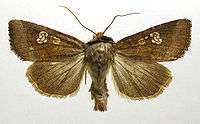Amphipoea oculea
| Amphipoea oculea | |
|---|---|
| Scientific classification | |
| Kingdom: | Animalia |
| Phylum: | Arthropoda |
| Class: | Insecta |
| Order: | Lepidoptera |
| Family: | Noctuidae |
| Genus: | Amphipoea |
| Species: | A. oculea |
| Binomial name | |
| Amphipoea oculea (Linnaeus, 1761) | |
| Synonyms | |
| |
The Ear Moth (Amphipoea oculea) is a moth of the Noctuidae family. It is found in most of the Palearctic ecozone.

The wingspan is 29–34 mm. Forewing pale or dark ferruginous brown; the veins brown; inner and outer lines double, brown, wide apart; the inner curvedoutwards between, and toothed inwards on, the veins; the outer with the inner arm thin, lunulate-dentate, the outer thick, continuous and parallel; a thick dark median shade running between the stigmata; submarginal line indistinct, waved, angled on vein 7, above which it is preceded by a dark costal patch; orbicular stigma rounded, orange, with a brown ring; reniform white, with the veins across it brown and containing on the discocellular a brown-outlined lunule, of which the centre is yellowish; the colour with brown outline; hindwing fuscous grey, paler towards base; the fringe rufous tinged.[1]
Adults are on wing from June to September depending on the location. There is one generation per year.
The larvae feed on the stems and roots of various grasses and low plants, including Petasites hybridus.[2]
Similar species
Requiring genitalic examination
References
- ↑ Seitz, A. Ed., 1914 Die Großschmetterlinge der Erde, Verlag Alfred Kernen, Stuttgart Band 3: Abt. 1, Die Großschmetterlinge des palaearktischen Faunengebietes, Die palaearktischen eulenartigen Nachtfalter, 1914
- ↑ "Robinson, G. S., P. R. Ackery, I. J. Kitching, G. W. Beccaloni & L. M. Hernández, 2010. HOSTS – A Database of the World's Lepidopteran Hostplants. Natural History Museum, London".
External links
- Ear Moth up UKmoths
- Funet Taxonomy
- Lepidoptera of Belgium
- Vlindernet.nl (in Dutch)
- Lepiforum.de Includes photo of genitalia